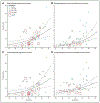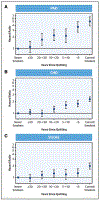Lower Extremity Peripheral Artery Disease: Contemporary Epidemiology, Management Gaps, and Future Directions: A Scientific Statement From the American Heart Association
- PMID: 34315230
- PMCID: PMC9847212
- DOI: 10.1161/CIR.0000000000001005
Lower Extremity Peripheral Artery Disease: Contemporary Epidemiology, Management Gaps, and Future Directions: A Scientific Statement From the American Heart Association
Erratum in
-
Correction to: Lower Extremity Peripheral Artery Disease: Contemporary Epidemiology, Management Gaps, and Future Directions: A Scientific Statement From the American Heart Association.Circulation. 2021 Aug 31;144(9):e193. doi: 10.1161/CIR.0000000000001019. Epub 2021 Aug 30. Circulation. 2021. PMID: 34460328 No abstract available.
Abstract
Lower extremity peripheral artery disease (PAD) affects >230 million adults worldwide and is associated with increased risk of various adverse clinical outcomes (other cardiovascular diseases such as coronary heart disease and stroke and leg outcomes such as amputation). Despite its prevalence and clinical importance, PAD has been historically underappreciated by health care professionals and patients. This underappreciation seems multifactorial (eg, limited availability of the first-line diagnostic test, the ankle-brachial index, in clinics; incorrect perceptions that a leg vascular disease is not fatal and that the diagnosis of PAD would not necessarily change clinical practice). In the past several years, a body of evidence has indicated that these perceptions are incorrect. Several studies have consistently demonstrated that many patients with PAD are not receiving evidence-based therapies. Thus, this scientific statement provides an update for health care professionals regarding contemporary epidemiology (eg, prevalence, temporal trends, risk factors, and complications) of PAD, the present status of diagnosis (physiological tests and imaging modalities), and the major gaps in the management of PAD (eg, medications, exercise therapy, and revascularization). The statement also lists key gaps in research, clinical practice, and implementation related to PAD. Orchestrated efforts among different parties (eg, health care providers, researchers, expert organizations, and health care organizations) will be needed to increase the awareness and understanding of PAD and improve the diagnostic approaches, management, and prognosis of PAD.
Keywords: AHA Scientific Statements; diagnosis; epidemiology; peripheral artery disease; prognosis; risk factors.
Conflict of interest statement
The American Heart Association makes every effort to avoid any actual or potential conflicts of interest that may arise as a result of an outside relationship or a personal, professional, or business interest of a member of the writing panel. Specifically, all members of the writing group are required to complete and submit a Disclosure Questionnaire showing all such relationships that might be perceived as real or potential conflicts of interest.
Figures




References
-
- Gerhard-Herman MD, Gornik HL, Barrett C, Barshes NR, Corriere MA, Drachman DE, Fleisher LA, Fowkes FG, Hamburg NM, Kinlay S, et al. 2016 AHA/ACC guideline on the management of patients with lower extremity peripheral artery disease: a report of the American College of Cardiology/ American Heart Association Task Force on Clinical Practice Guidelines. Circulation. 2017;135:e726–e779. doi: 10.1161/CIR.0000000000000471 - DOI - PMC - PubMed
-
- Creager MA, Belkin M, Bluth EI, Casey DE Jr, Chaturvedi S, Dake MD, Fleg JL, Hirsch AT, Jaff MR, Kern JA, et al. 2012 ACCF/AHA/ACR/SCAI/SIR/STS/SVM/SVN/SVS key data elements and definitions for peripheral atherosclerotic vascular disease: a report of the American College of Cardiology Foundation /American Heart Association Task Force on Clinical Data Standards (Writing Committee to Develop Clinical Data Standards for Peripheral Atherosclerotic Vascular Disease). Circulation. 2012;125:395–467 doi: 10.1161/CIR.0b013e31823299a1 - DOI - PubMed
-
- Hirsch AT, Haskal ZJ, Hertzer NR, Bakal CW, Creager MA, Halperin JL, Hiratzka LF, Murphy WRC, Olin JW, Puschett JB, et al. ACC/AHA 2005 practice guidelines for the management of patients with peripheral arterial disease (lower extremity, renal, mesenteric, and abdominal aortic): a collaborative report from the American Association for Vascular Surgery/ Society for Vascular Surgery, Society for Cardiovascular Angiography and Interventions, Society for Vascular Medicine and Biology, Society of Interventional Radiology, and the ACC/AHA Task Force on Practice Guidelines (Writing Committee to Develop Guidelines for the Management of Patients With Peripheral Arterial Disease). Circulation. 2006;113:e463–e654. doi: 10.1161/CIRCULATIONAHA.106.174526 - DOI - PubMed
Publication types
MeSH terms
Grants and funding
LinkOut - more resources
Full Text Sources
Other Literature Sources
Medical
Miscellaneous

